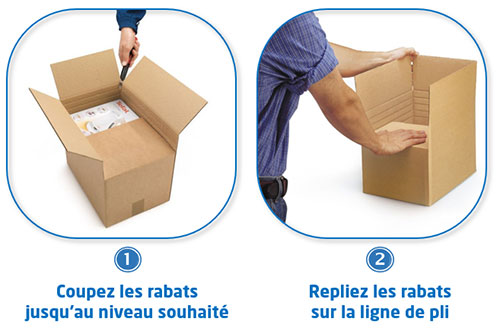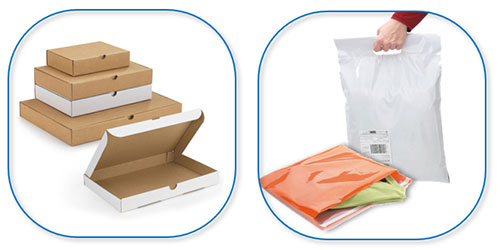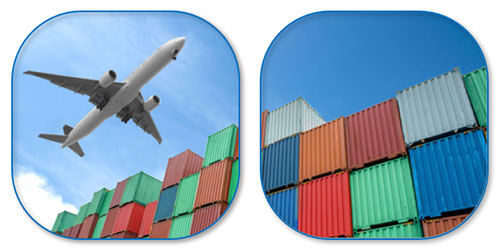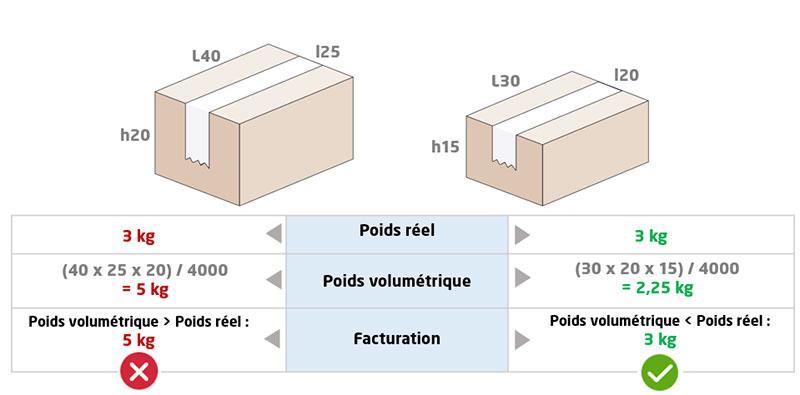With this article, we address an important topic for online shops: reducing shipping costs. One of the most effective measures in packaging is to reduce the amount of air in a crate, because air, in the world of transport, is paid for. We will look at a number of solutions to prevent unnecessary air shipments. We will also look at volume weight or volumetric weight: a handy calculation for those who want to learn how to ship more compactly (and more economically).
su_spacer]
1. Reduce your shipping costs in 5 ways
In the Netherlands, the e-commerce sector has set itself the goal
of
reducing CO2 emissions in logistics by 50%
by
2025. One of the measures to achieve this goal is to reduce the air in packaging: more parcels per truck, less travel, less CO2.1 As the Belgian and Dutch e-commerce sectors are closely linked, this measure will also be increasingly felt in our country. With the measures below, it will be easy for you to jump on the bandwagon and learn how to optimally manage your shipping costs. Make your parcels lighter, more compact… and cheaper.
► Clever packaging
A survey by Partners for Innovation shows that the average fill rate of a crate is 50%.1 This means that half of all shipments contain something other than the product ordered: usually cushioning material and/or air.If you want to reduce the void in your crate, use clever packaging.This type of packaging better adapts to the size of your product.
Take the variable height crate, for example.A single one of these crates can accommodate up to 12 different heights, depending on the size of your product.A practical solution for storing a single crate and transporting slightly different sized products.Looking for packaging with specific dimensions? Try our search engine, specifically designed for crates.

► Flat packaging and pockets
A second solution for sending in a more compact way is to use envelopes, letterboxes or mailing sleeves. They are becoming increasingly visible in the e-commerce sector as a substitute for the classic cardboard box. These packages are flatter and therefore take up much less space. In addition, they can be inserted directly into a letterbox and avoid unnecessary processing in a mailing centre
- Cardboard envelopes and mailboxes: for sending books, CDs, photo frames, etc.
- Plastic shipping pouch: for products that are not fragile, such as clothing or textiles or goods that already have strong packaging.

► Light as air
Doyou have to use cushioning material? Consider air cushions or Flo-Pak® cushioning particles. Packing with air is always the lightest solution. In addition, the plastic film of the air cushions is recyclable, as are most of the Flo-Pak® particles.
► Buy your packaging material in bulk
Buying in large quantities often results in significant discounts.So choose the packaging you use most often and buy it in large quantities.You’ll get a lower unit price and have fewer shipping costs.A good example is again the variable height crate.Instead of buying 10 types of crates, you only buy one (which you then adjust to the right height yourself).Therefore, you can buy the variable height crate in larger quantities and get a cheaper unit price.
► Opt for a full truck
Work with other companies to deliver your goods. Research has shown that 67% of trucks are not completely full to begin with.2 By working with surrounding companies, you can completely fill the truck and optimise your joint shipping costs.
2. What is the advantage of volumetric weight?

Le plus important est d’envoyer vos emballages de manière compacte. Pas seulement pour vos frais d’expédition, mais aussi pour vos clients, qui apprécieront de ne pas recevoir un produit suremballé. C’est ici qu’intervient le poids volumétrique. Il examine l’espace effectif qu’occupe un colis (par exemple, dans un camion ou un avion).
L’avantage principal par rapport au poids réel est que le poids volumétrique correspond mieux au type de marchandise et au moyen de transport. L’application de cette formule a, par exemple, rendu plus économique l’envoi de colis légers et compacts par voie aérienne. Les marchandises très lourdes et volumineuses sont, elles, transportées par bateau à meilleur prix.

Dans certains cas, les services de messagerie utilisent même le poids volumétrique comme point de départ principal pour calculer leurs frais d’expédition. Cela peut être le cas, par exemple, avec des livraisons express (en Europe et hors
Eu
3. How do you calculate volumetric weight?
Each courier service uses its own, slightly different, formula for calculating volumetric weight, so we advise you to consult your courier service’s terms and conditions before starting the final calculation. Most commonly, the actual volume is divided by a volume factor of between 1000 and 6000

The volume factor above (in this case 4000) depends on the method of transport. Below you can see which volume factor corresponds to which type of transport, however, the exact factor can vary from courier to courier, so you might as well check this before the calculation:
Air transport |
Road transport |
Sea transport |
| Volume factor: 5000 or 6000 | Volume factor: 3000 or 4000 | Volume factor: 1000 |
4. Actual weight vs. volumetric weight
Comme le volume d’un colis est de plus en plus contrôlé, il est probable qu’un nombre croissant de services de messagerie passent à l’avenir au poids volumétrique. Pour savoir si cela vous donne un avantage sur le poids réel ou non, veuillez suivre les 3 étapes ci-dessous.
► Étape 1 : déterminer le poids réel. Supposons que l’emballage pèse 3 kg lorsqu’il est rempli.
► Étape 2 : calculer le poids volumétrique. Supposons que nous expédierons notre colis par camion. Le facteur de volume dans notre exemple est de 4000.
► Étape 3 : déterminer le poids facturable. Maintenant que nous connaissons le poids réel et le poids volumétrique, nous pouvons les comparer. Le poids facturable est toujours basé sur la valeur la plus élevée.

 Conclusion by choosing a more compact box, you ship much more cheaply Our example shows that you save 2 kg of billable weight (3 kg instead of 5 kg).
Conclusion by choosing a more compact box, you ship much more cheaply Our example shows that you save 2 kg of billable weight (3 kg instead of 5 kg).
Sources:1 www.thuiswinkel.org/bedrijven/belangenbehartiging/duurzaamheid/ brancheverduurzamingsplan-verpakken-e-commerce-2019-20222 https://blog.raja.fr/astuces-reduire-cout-transport-marchandises














